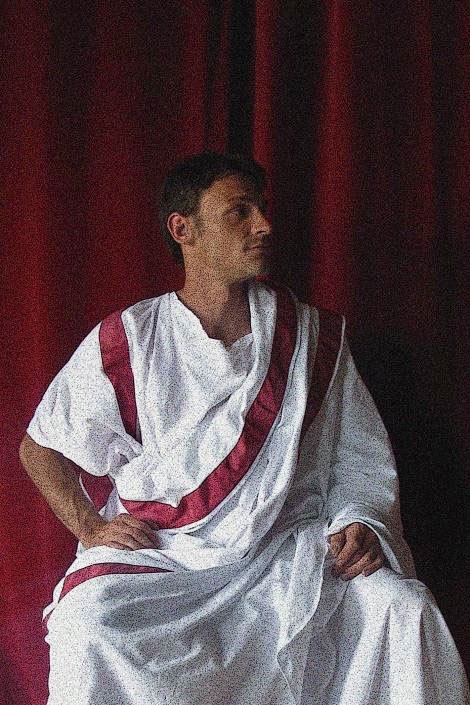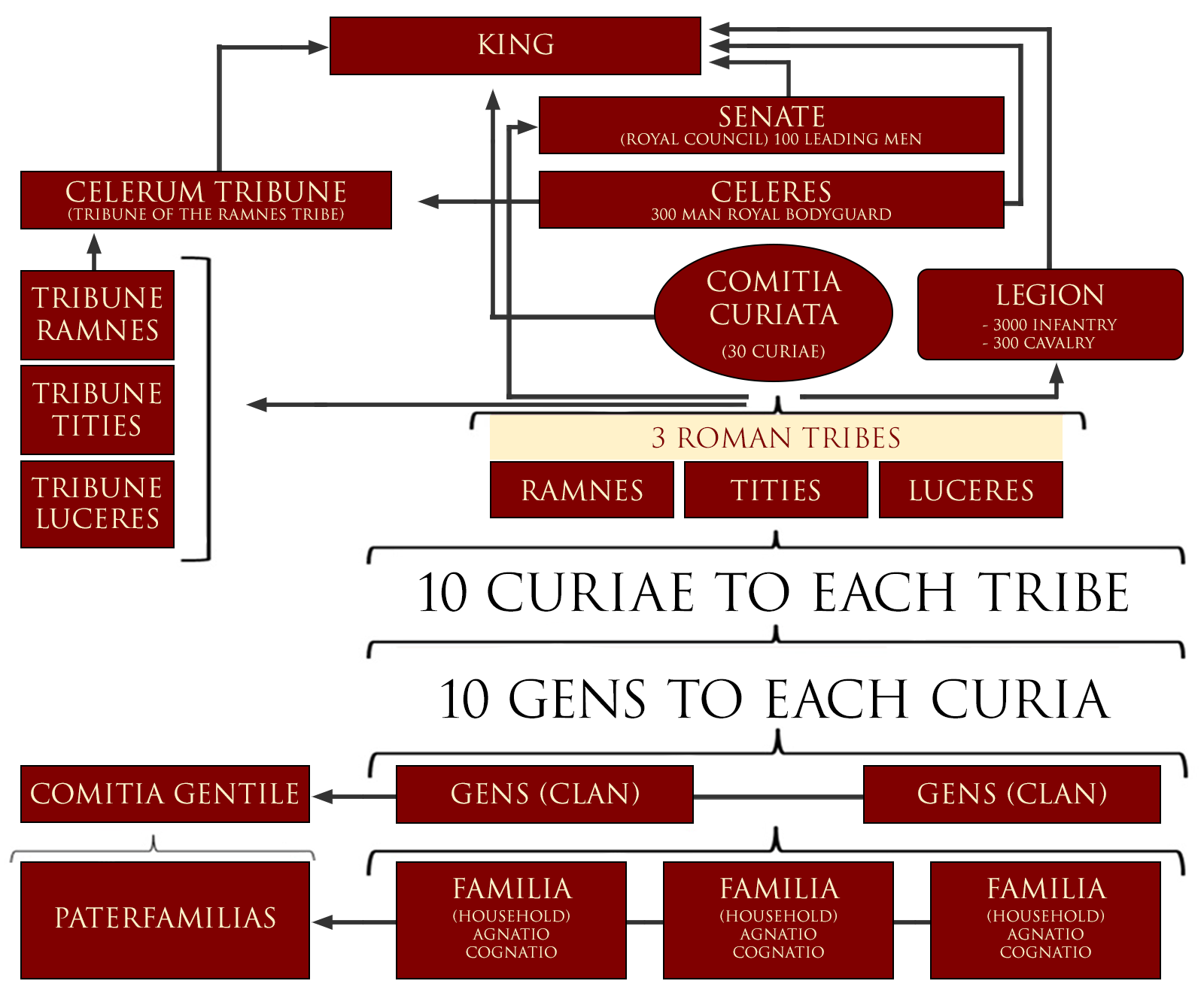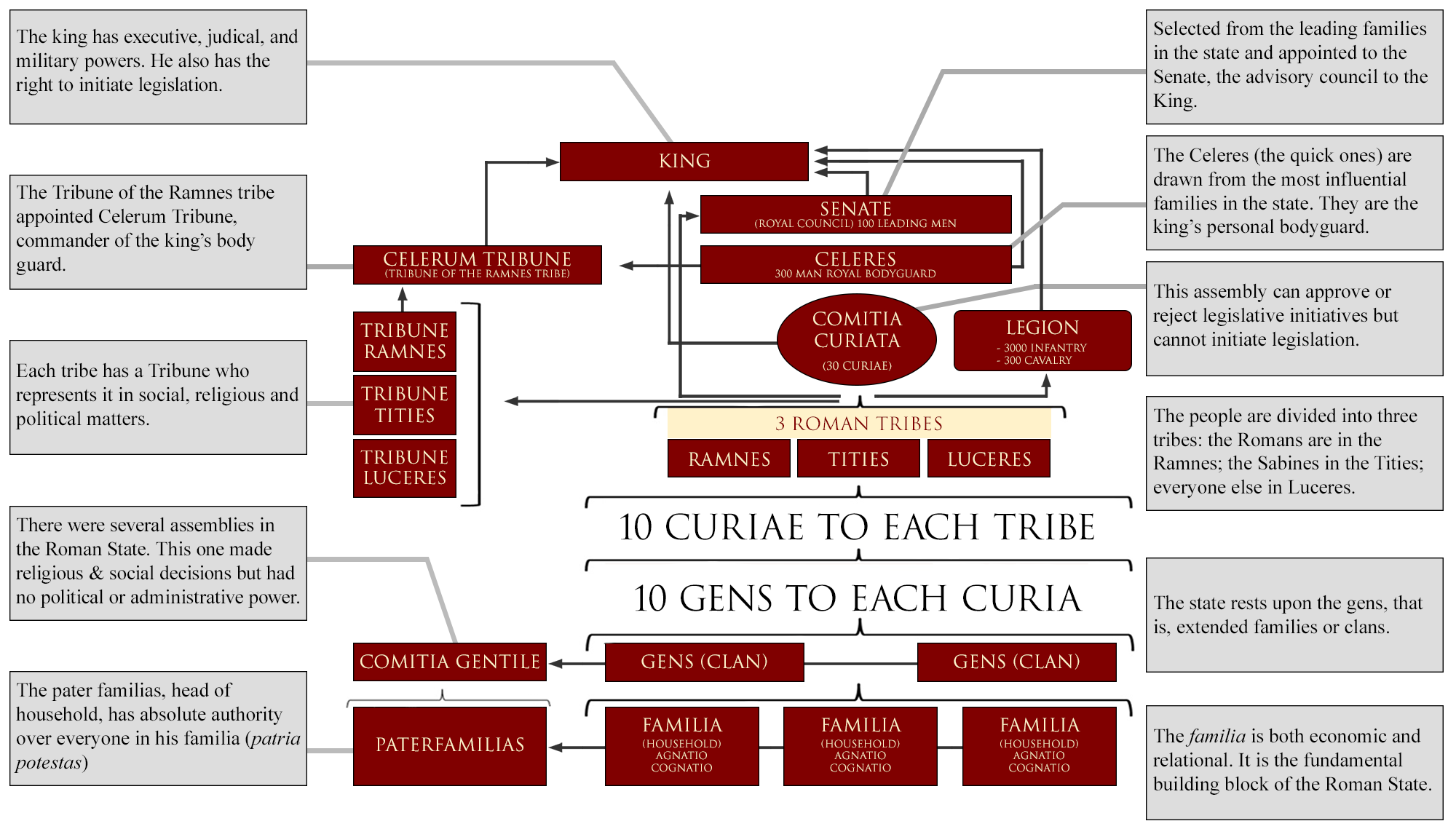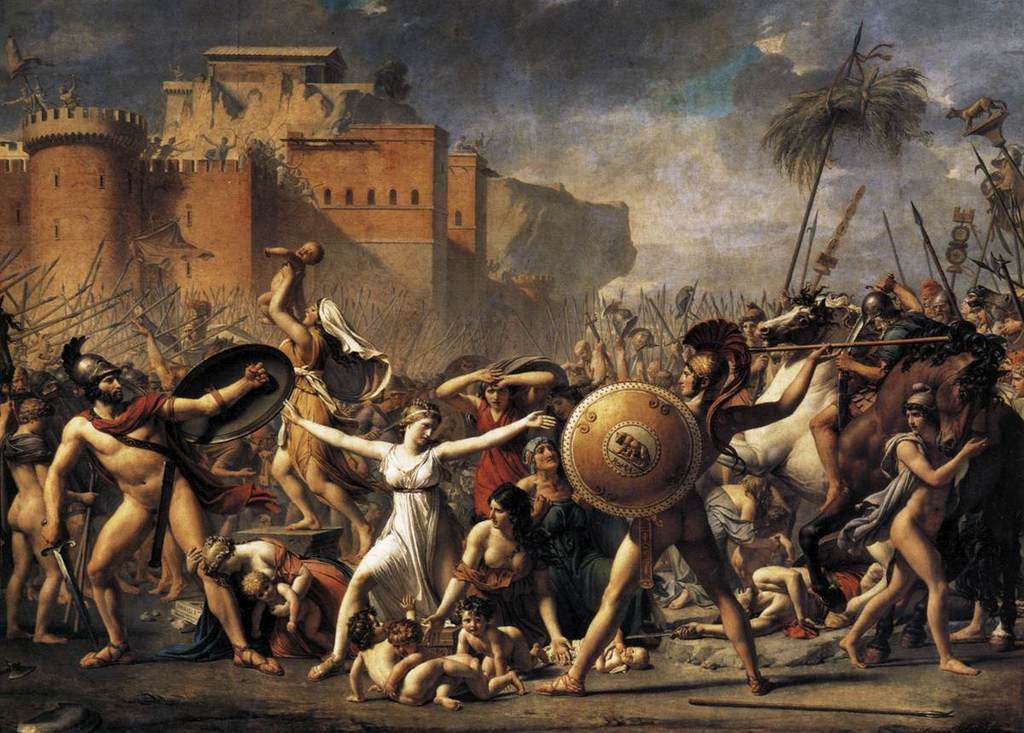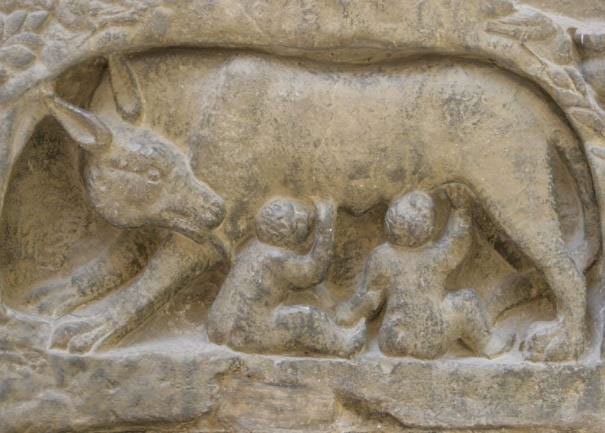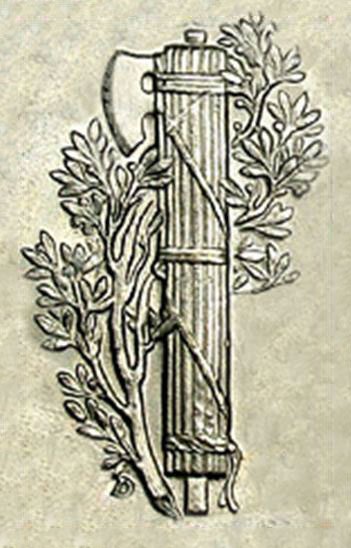Romulus
Romulus Introduces Important Symbols of Class Status and Rule – the Curule Chair and the Toga
Romulus introduced the curule chair (sella curulis) as an emblem of magistrate’s status and power; borrowed from Etruscans. He also introduced a gown edged in purple (purpura), indicating status; another idea borrowed from the Etruscans. Colored by purple dye derived from the mucus of two murex sea snail species (murex brandaris and murex trunculus) found in the eastern Mediterranean waters and worked as a monopoly by the Phoenician city of Tyre. The dye was used in royal robes and special ceremonial garments. It was labor intensive (10,000 creatures to produce sufficient dye for one garment) and very expensive. A pound of the dye would cost a laborer a month of his wages.
Senatorial toga.
Created and photographed by Z. Michalski for Pro Romanis, GENCYA Corp. User may use this image but only under the following conditions; that the image be accompanied by the following copy and link to this website: “This image is the property of Pro Romanis, GENCYA Corp. It may be reproduced for educational purposes only. The original may be viewed at www.proromanis.com.”
Senatorial togas had a broad Tyrian purple stripe to indicate their status. Equites, members of the class of knights (next class down with a lower property requirement), wore togas with a narrow purple stripe. Priests also wore purple ceremonial robes and an imperator (vir triumphalis/triumphator, conquering general), should he be fortunate enough to be awarded a triumph, wore a purple garment edged with gold (toga picta, painted toga) during his victory procession (triumph).
Romulus Establishes a Sanctuary as a Way to Expand the Population of Rome
Romulus also created a sanctuary—Asylaeum, the two groves (also known as the Lucus)—for slaves and freedmen fleeing from other states. These refugees, once they reached sanctuary, would never be returned to their masters if they were slaves, nor would murderers or other transgressors ever be returned for justice. This was a subversive device, one that gave the “outs” in surrounding states hope for a new start and the nascent Roman state a steady source of new manpower.
Romulus Organizes the Senate
Creates 100 Senators whom he called Fathers; their power deriving from the law of patria potestas (paterfamilias as the head and absolute authority of the family); their descendants were called Patricians.
Romulus Creates a Body Guard in order to Protect the Person of the King
Keeps a bodyguard of 300 soldiers called Celeres (quick ones). This information is found in Livy and may be a retrospective creation in order to set a precedent for the Praetorian Guard that protected Augustus.
Romulus Organizes the Archaic Roman State (Structural Diagram).
Created by J.S. Konrad, Pro Romanis. The diagram is based on Livy’s History of Rome and Theodore Mommsen’s History of Rome (Volume 1). May be used for educational purposes only provided it is accompanied by the following language and link: “Romulus organizes the archaic Roman state (Structural Diagram) is the creation and property of Pro Romanis, GENCYA Corp. For more information, please visit www.proromanis.com.
Romulus Organizes the Archaic Roman State (Functional Diagram).
Created by J.S. Konrad, Pro Romanis. The diagram is based on Livy’s History of Rome and Theodore Mommsen’s History of Rome (Volume 1). May be used for educational purposes only provided it is accompanied by the following language and link: “Romulus organizes the archaic Roman state (Functional Diagram) is the creation and property of Pro Romanis, GENCYA Corp. For more information, please visit www.proromanis.com.
Putting the Expansion of the Population of Rome on a Firm Footing–Abduction of the Sabine Women
Legend of the abduction of the Sabine women: Romans had no women so they held a feast honoring Neptunus Equitus to which they invited surrounding peoples including the Sabines who brought their wives and daughters. When everyone was preoccupied with the festivities, the Roman men at a signal from Romulus abducted the Sabine maidens for wives. The Sabines were outraged, war ensued, and as the Romans and Sabines fought, the daughters intervened begging for peace.
Relatives of the Sabine women migrate to Rome, thereby enlarging the state substantially. The way the Sabines were incorporated into city government was to have the Romans vote for a King from the Sabines and for the Sabines to vote for a King from the Romans. Romulus and Tatius were elected the first Kings.
Rape of the Sabine Women.
By Jacques-Louis David.
Romulus as Brave War Hero
Romulus kills enemy general (Acron) by his own hand and dedicates temple to Jupiter Feretrius, 1st temple consecrated in Rome. Romulus cuts down an oak staff and dresses it with the armor of the slain enemy. This is the beginning of the tradition of awarding the spolia opima for slaying an enemy leader in single combat. He is given a triumph, a victory procession. This was the first of three that he would be awarded.
Romulus’ Death
Legend of Romulus’ death: vanishes in a thunderstorm, later appears to Proculus Julius and commands the Romans to cultivate the art of war and that Rome will become capital of the world. He then ascended into heaven. Romulus had grown increasingly autocratic. He was probably slain and his body disposed of by the patrician council. The people suspected as much which is why the Senators concocted the ascension into heaven tale. Romulus acquired his kingship by violence (he is said to have killed his brother Remus) and his reign ended in violence.
The Historicity of Romulus
The Regal period of the city state of Rome is in all likelihood a mixture of legend, myth and historical fact (Mommsen thought it was fiction). There is a very ancient oral tradition that made its way down from the earliest years. The content of the tradition was embedded in Roman identity and in all likelihood was included in the written annals of a later time. The written annalistic tradition, however, had a great gap created by the Gallic sack of Rome sometime between 390 and 386 BC, when all of the records were destroyed along with much of the city.
We have no way of knowing if Romulus was an actual person. It could be that there was such an individual, or it could be that Romulus was a composite of several Roman kings or simply a poetic creation that helped explain the origins of Rome and of her institutions. What’s more certain and more relevant is that the ancient Romans were convinced that he was real. In fact there is no known Roman counter narrative to the Romulus foundation story, and no Roman writer from Fabius Pictor onward finds credible any of the Greek versions that offer another explanation of the founding [1].
[1] Rodriguez–Mayorgas, A. Romulus, Aeneas and the Cultural Memory of the Roman Republic Amministrazione Di Athenaeum Universita Pavia 201.
Carving of Romulus and Remus being suckled by a she wolf.
From the Museum of Roman Civilization.
As for the Roman foundation narrative, two holidays are believed to celebrate the founding of the city by Romulus; the Parilia (celebrated April 21 and dedicated to the god Pales) in which the shepherds leave their huts to found Rome; and, the Lupercalia on February 15, in which young men race around the city with the skins of sacrificed goats, striking anyone in their path. The Luperci (young aristocrats participating in the ritual race) were believed to be reenacting the lives of Romulus and Remus as shepherds.
The Romulus–Remus story begins with a usurpation of an older brother’s power, Numitor, by a younger brother, Amulius. He banishes his older brother, eliminates his male issue and makes his niece, Rhea Sylvia, a Vestal Virgin, thus preventing her from having offspring that can challenge his rule in the future. Somehow, Rhea Silvia becomes pregnant. She claims she has been raped by the god Mars. There is speculation that Amulius is the father. As a consequence, Rhea Silvia is thrown into prison and a command is given to drown the twins. They are exposed at the river Ruminalis, but are not carried away by the current or drowned. A she wolf coming down from the mountains hears the children’s cries and suckles them. A shepherd by the name of Faustulus finds them and he carries them back to his hut to be nursed by his wife Laurentia.
Because they were twins, Romulus and Remus couldn’t determine which brother had precedence and which would name the city they intended to found. Thus they agreed to determine the naming and the rule of the city by ascertaining the will of the local gods by means of augury. Remus chose the Aventine hill and was the first to observe six vultures flying overhead; Romulus, who chose the Palatine hill, a while later, observed 12 vultures. Each brother and his adherents claimed the kingdom, Remus on the ground of priority of time, Romulus on the ground of the number of birds. Argument escalated to blows and Remus was killed in the resulting melee. The historian Livy writes that a more common account is that “Remus, in derision of his brother, leaped over his new-built wall [actually a symbolic furrow, representing the pomerium (boundary), plowed around the Palatine], and was, for that reason, slain by Romulus in a passion; who, after sharply chiding him, added words to this effect” ‘So shall every one fare, who shall dare leap over my fortifications.”
The Rule of Romulus–Summary
Having his rule validated by divine will (the appearance of 12 vultures) and backed by force (the slaying of his brother Remus), Romulus proceeded to organize his city after satisfying certain religious rituals. He gave his people a code of laws, he took on the insignia of authority (12 lictors; see below). Livy writes that the idea of these lictors, the symbols of imperium (legitimate executive power), was borrowed from the Etruscans (as were the purple bordered gown and the curule chair; see Livy Book 1, page 14).
Fasces.
The fasces, is an ax encompassed by a bundle of rods. It was a symbol of authority in the Roman state, usually accompanying Roman magistrates when performing their duties.
In order to augment the population of this newly formed state, Romulus established a sanctuary of the two groves where slaves or freemen from neighboring states could find sanctuary for whatever reasons. It was a clever population growth mechanism but it’s easy to see how this kind of place could become a source of friction with neighboring city states.
Having a ready source of people, Romulus had to find a body that would direct the state, so he established a Senate of 100 senators; men who were called Fathers and their descendants Patricians.
Livius, T. The History of Rome, Books 1-to-8. Trans. D. Spillman. London. Henry G. Bohn, York Street, Covent Garden. 1853. John Childs and Son, Bungay. Project Gutenberg. Produced by Ted Garvin, Taavi Kalju and the Online Distributed Proofreading team at http://www.pgdp,net. November 6, 2006. EBook #19725. Page 13.

